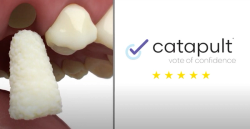- About Us
- Advertise
- Editorial
- Contact Us
- Terms and Conditions
- Privacy Policy
- Do Not Sell My Personal Information
© 2025 MJH Life Sciences™ and Dental Products Report. All rights reserved.
Instrumentation for all-ceramics
Through the accelerated advancement of CAD/CAM technology and material science, dentists have several new, high strength all-ceramic materials in the indirect portfolio to choose from. The recent dramatic increase in the cost of gold in combination with current economic conditions is accelerating demand for these new products. Dentists are prescribing these new metal-free all-ceramic restorations at a rapidly accelerating pace.
Through the accelerated advancement of CAD/CAM technology and material science, dentists have several new, high strength all-ceramic materials in the indirect portfolio to choose from. The recent dramatic increase in the cost of gold in combination with current economic conditions is accelerating demand for these new products. Dentists are prescribing these new metal-free all-ceramic restorations at a rapidly accelerating pace. As a result, dental technicians are faced with the need to develop new skills for manufacturing as well as finishing processes for these new advanced, high strength all-ceramic materials. In this article, I share recent developments in rotary instruments that facilitate trimming sintered zirconia as well as lithium disilicate.
Historically, technicians have been trimming, cutting or grinding feldspathic ceramic materials. These materials have a victor hardness of about 6.4 GPa. The newer, higher strength lithium disilicate and post sintered zirconia materials have a victor hardness of about 12.75 GPa. As a result, it is necessary to develop new protocols and rotary instruments that cut these harder materials efficiently while simultaneously keeping heat transfer as low as possible. We have been working with Wagner Precision Rotary Instruments to develop a new line of rotary products that meet the challenges of today’s harder all-ceramic materials.
Sintered zirconia
Sintered zirconia is not a good conductor of heat. When friction from grinding occurs the heat does not transfer through the material. When trimming the material the area that is in contact with the rotary instrument becomes hot, while the ceramic adjacent to the trimmed area remains comparatively cool. Post sintered zirconia, like most materials, expands under heat. This localized temperature differentiation can cause failure or cracking. Finishing post sintered zirconia, both full contour and frameworks, should be performed using irrigation and selecting rotaries that minimize heat transfer.
Finishing sintered zirconia
01 We first check for fit. If internal adjustments are necessary we will use Red Quickcheck Indicator Spray fit check spray. Observation of areas of interference can be adjusted with either a FG1C or an FG2E (Fig. A).
02 Zirconia margins can be thinned nicely using a friction grip fine diamond at low highspeed with irrigation and a light touch. For thinning post sintered margins on zirconia frameworks we use a fine football-shaped FG5C tool. This will aid in thinning out chamfer or shoulder areas while simultaneously thinning out the margins. For full-contour zirconia, using a straight or slightly tapered diamond FG5C will result in a beautiful knife edge margin and aid in providing a proper emergence profile (Fig. B).
03 Use a FG4A to adjust occlusal contacts. Refine proximal contacts with an FG1C.
04 Adding anatomical detail to post sintered zirconia is perhaps the most difficult rotary problem in the finishing process. Great care should be taken in the CAD stage to ensure proper occlusal contacts and morphology. This can be achieved with most CAD programs and a good anatomic library. If there are small morphological alterations needed, use an FG3A (Fig. C). Microscopic marginal integrity can be evaluated in Figures D and E.
05 Studies show the surface wear of zirconia to opposing natural dentition is less than feldspathic porcelain. Tests were performed with polished occlusal zirconia surfaces as well as unpolished occlusal surfaces. The conclusion of these studies was favorable only on the polished zirconia surface. Before stain and glaze it is imperative to polish zirconia with the RedBerry™ and BlueBerry™ wheels (Fig. F).
06 Last is a light sandblast to the outer surface with 50 micron aluminum oxide at 30 lbs., before stain and glaze. Wagner Rotary Instruments also has developed an adjustment kit for chairside adjustment and intraoral polishing.
Finishing lithium disilicate
In accordance with protocol developed by Ivoclar Vivadent grinding on lithium disilicate (e.max™) should be performed with irrigation. A step by step protocol for finishing lithium disilicate press includes different rotaries.
01 Check the fit. Generally, the restoration will drop on. If there is interference in seating, an FG1D highspeed diamond tool is used internally to remove any interfering material. If the interference is within .75 mm of the margin I recommend using a small knife edge BlueBerry™ at a very slow speed. Unlike zirconia, lithium disilicate margins are far more delicate and can possibly chip.
02 Once fit, remove the sprue with a Large DiaCool wheel (Fig. G). DiaCool is specifically designed to provide bulk reduction with minimal heat transfer.
03 Thin or finalize the crown margin with a diamond impregnated coarse BlueBerry™ (Fig. H). It is critical to use an instrument that smooths as it cuts through the ceramic. Again, grinding with a diamond or cutting with a carbide likely will result in chipping and/or fracturing the margin. The RedBerry™ and BlueBerry™ combination reduces tool chatter, vibration and chipping.
04 Final interproximal contact adjustments should be performed on a solid cast. Using articulating paper we can check for premature surface contacts.
05 Once you transfer markings to the restoration, remove any excess material with an FG4A diamond tool. The addition of posterior occlusal anatomical features can be accomplished using a FG169L. When redefining anatomical morphology, work from the outer perimeter of the occlusal surface to the fossa. This reduces the risk of fracturing the lithium disilicate. Hold the tool at a 45° angle and perpendicular to the anatomical feature being cut. Use a combination of tools for labial surface anatomy. For anterior restorations, develop vertical surface anatomy with a FG1C followed by a FG3A.
06 Before stain and glaze, smooth remaining surface imperfections and scratches with a BlueBerry™.
07 Final High Shine polishing is accomplished with Wagner’s 26 mm knife edge Golden eagle #641.
For videos on finishing these materials visit CAP-US.com.



